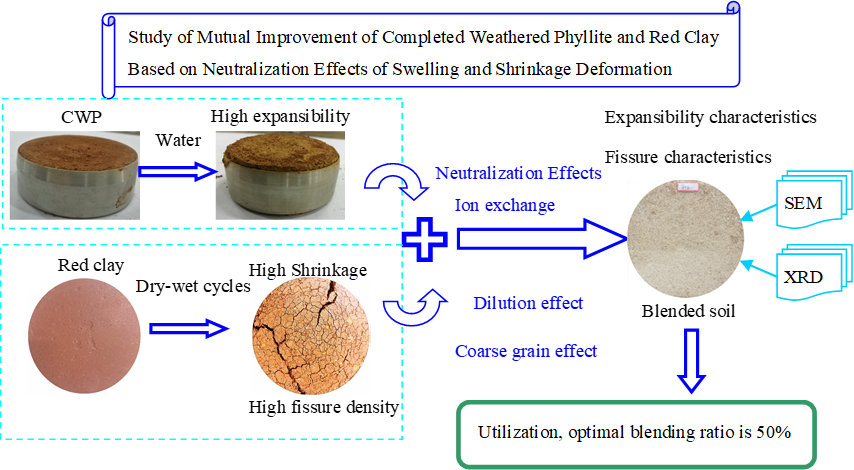 Open Access
Open Access
ARTICLE
Study of Mutual Improvement of Completed Weathered Phyllite and Red Clay Based on Neutralization Effects of Swelling and Shrinkage Deformation
1
Engineering Research & Development Centre for Underground Technology of Jiangxi Province, East China Jiaotong University, Nanchang, 330013, China
2
Arcadis AustraliaPacific Pty Ltd., Sydney, Australia
* Corresponding Author: Qijing Yang. Email:
Journal of Renewable Materials 2022, 10(1), 203-218. https://doi.org/10.32604/jrm.2021.015854
Received 19 January 2021; Accepted 19 February 2021; Issue published 27 July 2021
Abstract
Completely weathered phyllite (CWP) soil is a kind of special soil with high swell potential, while red clay is a special soil with high shrinkage. This means that these two kinds of special soils are usually not suitable for direct use as subgrade fill. To reduce the swell index of the CWP soil and the shrinkage of red clay at the same time, it was proposed to blend the CWP soil with red clay to improve their basic characteristics. A series of swell index tests and dry-wet cycle tests of the blended soils have been carried out at varying blending ratios, compaction coefficients and moisture contents. The test results show that the free swell index of the blended soil decreases with the increase of red clay, moisture content and compaction coefficient, respectively. The fissure density of the blended soil first decreases and then increases with the blending ratio, with the lowest being zero when the blending ratio is ranging from 20% to 40%. Through particle microscopic analysis and elemental composition analysis, it is found that the neutralization effect, the dilution effect of swell minerals, and the partition effect of coarse particles play an important role in restraining expansion and shrinkage deformation of the blended soil. Based on the liquid limit requirement of Chinese Railway Design Code (TB 10001-2016), the optimal blending ratio of red clay has been proposed to be 50%. Compared with the CWP soil, the free load swell index of the blended soil is reduced by 45.0% and the fissure density is reduced by 99.3% compared with that of red clay. Therefore, it is feasible to improve the CWP soil by blending it with red clay at an optimal ratio of 50% by using the neutralization effect of the expansion of CWP and shrinkage of red clay.Graphic Abstract

Keywords
Cite This Article
 Copyright © 2022 The Author(s). Published by Tech Science Press.
Copyright © 2022 The Author(s). Published by Tech Science Press.This work is licensed under a Creative Commons Attribution 4.0 International License , which permits unrestricted use, distribution, and reproduction in any medium, provided the original work is properly cited.


 Submit a Paper
Submit a Paper Propose a Special lssue
Propose a Special lssue View Full Text
View Full Text Download PDF
Download PDF Downloads
Downloads
 Citation Tools
Citation Tools